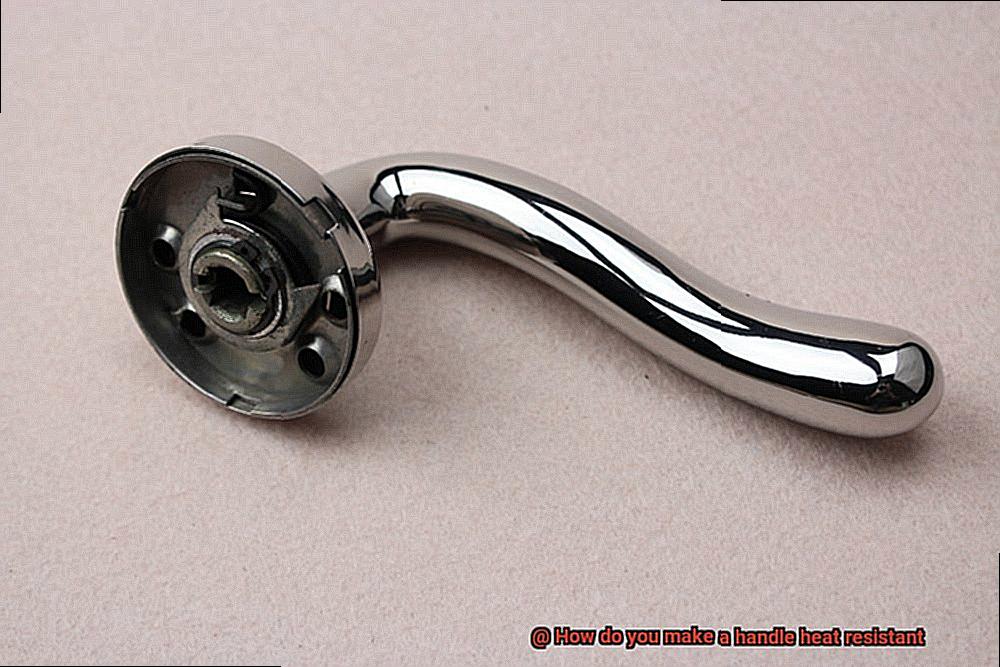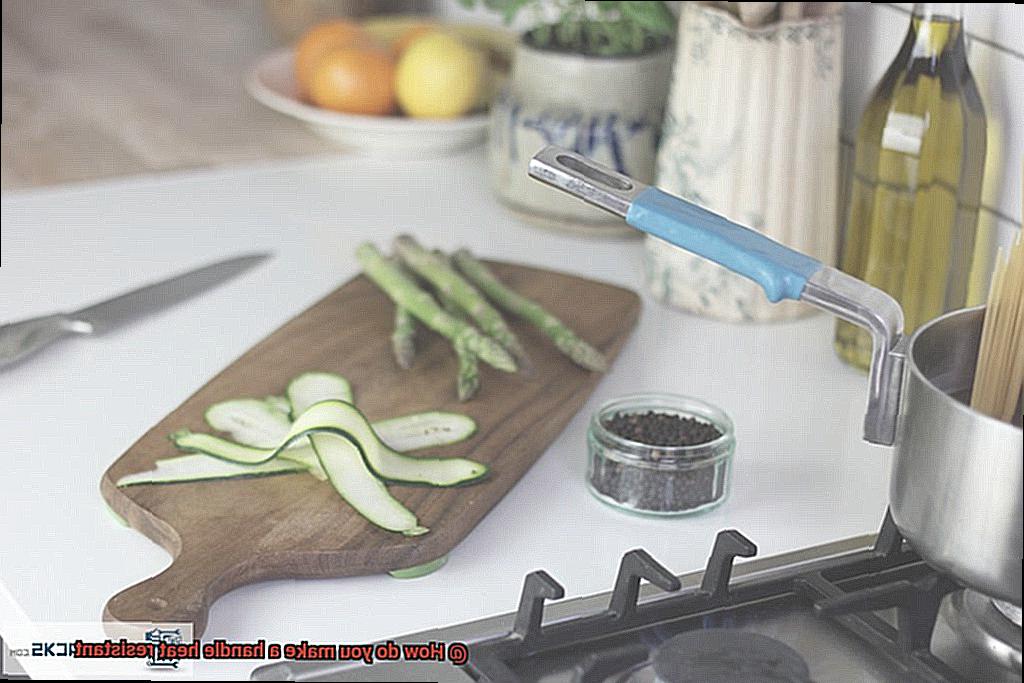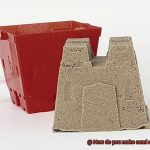Are you tired of burning your hands on scorching hot handles while cooking up a storm? It’s a real pain, isn’t it? Well, worry no more. In this blog post, we’re diving deep into the world of heat-resistant handle solutions. We’ll uncover all the secrets and techniques to transform any handle into a cool and safe companion in the kitchen or workshop.
Imagine effortlessly flipping pancakes without fear of singeing your fingertips. Picture confidently grabbing that sizzling hot pan handle without batting an eye. Sounds like a dream, right? Well, it doesn’t have to be.
From pans to tools and everything in between, we’ve got you covered. We’ll explore an array of materials and methods that will make your handles heat resistant in no time. Say goodbye to those pesky burns and hello to culinary confidence.
So go ahead, grab yourself a cup of joe (or maybe something cooler if it’s sweltering outside), kick back, and let us guide you through the exciting world of heat-resistant handles. Together, we’ll conquer the heat and make cooking a breeze again.
Heat-Resistant Coatings
Contents
When it comes to handling hot objects, safety and comfort are paramount. Gripping a scorching-hot pot handle or a sizzling barbecue tool can be an unpleasant experience. Fortunately, heat-resistant coatings provide the solution. In this blog post, we will explore the importance of heat-resistant coatings for handles and how they enhance safety and comfort.
Why Heat-Resistant Coatings Matter:

Heat-resistant coatings are specially formulated to withstand high temperatures and protect the underlying material from heat damage. Acting as a barrier between the handle and the heat source, they prevent heat transfer, ensuring that the handle remains cool to touch. This feature is crucial in situations where handles are exposed to extreme temperatures, such as in kitchens, industrial settings, or outdoor activities.
Types of Heat-Resistant Coatings:
- Ceramic-based Coatings: With excellent thermal insulation properties, ceramic coatings are made from inorganic materials like oxides, carbides, or nitrides. They form a protective layer on the handle surface, acting as a shield against high temperatures.
- Silicone-based Coatings: Offering resistance to heat, moisture, and chemicals, silicone coatings are flexible and durable. Ideal for various handle materials and shapes, they can withstand temperatures up to several hundred degrees Celsius without losing effectiveness.
- Epoxy-based Coatings: Combining heat resistance with high strength and durability, epoxy coatings adhere well to different surfaces. Applied in thin layers, they ensure a smooth finish on the handle and are commonly used in industrial settings.
Applying Heat-Resistant Coatings:
To apply a heat-resistant coating on a handle, several steps must be followed. Firstly, the handle must be thoroughly cleaned to ensure proper adhesion of the coating. Any dirt, grease, or previous coating should be removed using appropriate cleaning agents. After cleaning, the handle should be completely dried before applying the coating.
The coating can be applied using various methods such as spraying, brushing, or dipping, depending on the type of coating and handle material. Multiple layers may be necessary to achieve the desired thickness and heat resistance. Each layer should dry or cure according to the manufacturer’s instructions before applying the next.
After application, the coating should be cured at the recommended temperature and duration. This process ensures that the coating fully bonds to the handle surface, developing its maximum heat resistance. Once cured, the handle is ready for use and can withstand high temperatures without becoming hot.
Heat-Resistant Materials
There’s a solution to your problem – heat-resistant materials. These amazing materials are specifically designed to withstand high temperatures, ensuring that your handles stay cool and comfortable to touch. Let’s dive into the world of heat-resistant materials and discover the different options available.
First up, we have silicone. This versatile synthetic material is known for its excellent thermal stability. It can endure temperatures ranging from -60°C to 230°C (-76°F to 446°F) without losing its physical properties. Say goodbye to burnt fingers with silicone handles found in kitchen utensils and cookware, providing a comfortable grip while protecting you from heat transfer.
Next on the list is phenolic resin. These thermosetting polymers exhibit exceptional thermal resistance, withstanding temperatures up to 150°C (302°F) without melting or deforming. When it comes to industrial equipment and appliances like irons or hair dryers, phenolic resin handles are the go-to choice for their ability to handle high temperatures.
Ceramic materials are also popular choices for heat-resistant handles. With their excellent thermal shock resistance, ceramics can endure rapid temperature changes without cracking or breaking. Professional-grade cooking utensils and tools often feature ceramic handles, providing a reliable grip even in intense heat.
But wait, there’s more. Fiberglass-reinforced plastics (FRPs) combine the strength of fiberglass with the heat resistance of polymers. These materials can withstand temperatures up to 200°C (392°F) and are commonly used in automotive components or industrial tools where both durability and heat resistance are crucial.
When it comes to selecting the right heat-resistant material for your handle, several factors come into play. Consider the anticipated temperature range, frequency and duration of exposure to heat, as well as the desired mechanical properties. Manufacturers conduct extensive testing and evaluation of different materials to ensure their suitability for heat-resistant handles.
Design Considerations for Heat Resistance
In this blog post, we will dive into the world of heat-resistant handles and explore the key design considerations that go into creating these lifesavers. Whether you’re a culinary maestro or a kitchen enthusiast, this article is your ticket to handling the heat with ease and confidence.
Material Selection: The Foundation of Heat Resistance
The first step in designing a heat-resistant handle is selecting the right material. Stainless steel and aluminum are renowned for their high thermal conductivity, making them top choices for withstanding scorching temperatures without warping or melting. However, heat-resistant plastics and composite materials can also be utilized, provided their temperature limits and mechanical properties are carefully evaluated.
Insulation: Banishing the Burn
Nobody wants to experience the searing pain of burnt fingers. To minimize heat transfer and protect our delicate hands, incorporating insulating materials between the handle and the hot surface is essential. Heat-resistant coatings or layers of insulation materials like silicone or ceramic can be applied to the handle, acting as a protective shield against intense heat. Additionally, optimizing the shape and size of the handle can further reduce heat conduction.
Ergonomics: From Comfort to Control
While heat resistance is paramount, comfort and safety should not be overlooked. A well-designed handle should provide a secure grip, preventing slippage even when dealing with piping-hot objects. Ergonomic features such as textured surfaces, contoured shapes, or finger grooves elevate grip strength while reducing strain on the hand. Remember, a comfortable grip equals better control and fewer accidents.
Structural Integrity: Toughness that Endures
A heat-resistant handle must possess unwavering strength to withstand demanding conditions. It must boast adequate load-bearing capacity, mechanical resilience, and resistance to thermal expansion and contraction. Reinforcing the handle design with metal inserts, ribs, or gussets enhances its structural integrity. Furthermore, ensuring a secure attachment to the intended object through appropriate fastening methods or mechanisms is crucial.
Testing and Certification: Proving Excellence
Last but not least, rigorous testing and certification are vital to guarantee the quality and safety of a heat-resistant handle. Subjecting the handle to heat exposure tests, load tests, and durability tests under various conditions allows for thorough evaluation of its performance. Acquiring certifications from recognized authorities assures users that the handle meets industry standards and regulations for heat resistance.
Heat-Resistant Additives
Well, fear not. We have the perfect solution for you – heat-resistant additives. These remarkable substances are blended into the material used to make handles, giving them the ability to withstand high temperatures without becoming too hot to handle. In this blog post, we will delve deeper into the world of heat-resistant additives, exploring the different types used in handle manufacturing and how they enhance heat resistance.
One of the most popular heat-resistant additives is ceramic fiber. Derived from inorganic materials such as alumina and silica, ceramic fibers possess exceptional thermal insulation properties.
When incorporated into handle material, these fibers create a protective barrier that blocks the transfer of heat, ensuring your hands remain cool and safe. This makes ceramic fiber an ideal choice for handles that come into contact with hot surfaces or are exposed to high temperatures.
Another fantastic heat-resistant additive is silicone. This versatile polymer has the unique ability to withstand extreme temperatures without losing its shape or integrity. When blended into handle material, silicone forms a resilient layer that acts as a formidable heat barrier, preventing the handle from absorbing or transferring heat. Moreover, silicone offers superb non-slip properties, providing you with a secure grip even when the handle becomes scorching hot.
Polyimide is yet another highly effective heat-resistant additive utilized in handle manufacturing. Renowned for its exceptional thermal stability and mechanical strength, polyimide can endure prolonged exposure to high temperatures without degradation. By incorporating polyimide into handle material, manufacturers can produce handles that can withstand intense heat without compromising safety or functionality.
In addition to these specific additives, there are also general-purpose heat-resistant additives available. These additives typically consist of a blend of various substances designed to enhance a handle’s ability to endure high temperatures. They may include fillers like glass fibers or specialized resins that improve heat resistance while maintaining durability and strength.
It is important to note that proper manufacturing techniques and quality control measures are essential when using heat-resistant additives. The additives must be evenly dispersed throughout the handle material to achieve optimal heat resistance. Additionally, the handle’s design and structure should be carefully considered to minimize heat transfer and maximize user safety.
Pros and Cons of Different Heat-Resistant Methods
Fear not. In this blog post, we’ll delve into the world of heat-resistant methods, uncovering their advantages and disadvantages. From thermal insulation materials to heat-resistant coatings and adhesives, as well as heat-resistant materials themselves, let’s explore the diverse options available to transform ordinary handles into heat-defying heroes.
Thermal Insulation Materials:
- Pros: Ceramic fibers, mineral wool, and refractory bricks provide excellent heat resistance by blocking the transfer of fiery temperatures. They ensure safety with their insulation properties.
- Cons: These materials can be bulky, adding weight and affecting maneuverability. Additionally, some may have health and safety concerns when heated.
Heat-Resistant Coatings:
- Pros: Coatings made from special polymers or ceramics offer an extra layer of protection against high temperatures. They withstand heat without degrading or losing effectiveness.
- Cons: Coatings may wear off over time and require periodic reapplication. Some coatings may introduce potential health risks or emit harmful fumes when exposed to high temperatures.
Heat-Resistant Adhesives:
- Pros: These adhesives maintain bonding strength under high temperatures. They attach heat-resistant materials like silicone or fiberglass onto handles for added protection.
- Cons: Careful selection and application are necessary. Some adhesives may not provide sufficient bonding strength or compatibility with handle materials.
Heat-Resistant Materials:
- Pros: High-temperature alloys and ceramics used for handle construction offer inherent heat resistance without deforming or transferring excessive heat to hands.
- Cons: These materials can be expensive and require specialized manufacturing techniques. Some may be less durable than traditional handle materials.

Safety Guidelines for Handling Hot Objects
Hot objects can pose a serious risk of burns and injuries if not handled with caution. Whether you’re working in a kitchen, lab, or any environment where hot objects are present, following safety guidelines is crucial. In this blog post, we will discuss essential safety guidelines for handling hot objects, ensuring your protection and minimizing the risk of accidents.

Use Appropriate Protective Gear:

Equip yourself with heat-resistant gloves or mitts designed to withstand high temperatures and provide insulation against heat. Ensure they fit properly, covering hands and wrists completely, to prevent burns or accidents caused by loose or ill-fitting gloves.
Be Mindful of Temperature:
Always determine the temperature of the object before touching it. Use a thermometer to accurately assess the heat level. This step helps you avoid severe burns and handle the object safely.
Maintain a Firm Grip:
Securely hold the handle or object you are handling to prevent accidents and spills caused by slippery surfaces or inadequate grip. Take extra precautions to ensure a firm grip and avoid burns or injuries.
Stay Alert and Focused:
Maintain focus on the task at hand when working with hot objects. Avoid distractions and remain cautious throughout the process. Staying alert and attentive prevents accidental contact with hot surfaces or objects.
Keep Away from Flammable Materials:
Ensure hot objects are kept away from flammable materials or liquids at all times. Even a small accident or spill can quickly escalate into a fire hazard if hot objects come into contact with flammable substances. Keep your surroundings clear of potential fire risks.
Never Leave Hot Objects Unattended:
Never leave hot objects unattended. Place them on heat-resistant surfaces or in designated areas where they won’t pose risks to others. Neglecting this guideline can lead to accidents or injuries for yourself and those around you.
Allow Objects to Cool Down:
After using a hot object, give it ample time to cool down before attempting to clean or store it. Trying to handle a hot object immediately after use increases the risk of burns. Practice patience when dealing with hot objects.
Follow Manufacturer’s Instructions:
Always follow the manufacturer’s instructions and guidelines when handling specific hot objects, like cookware or electrical appliances. These guidelines ensure safe usage and should never be disregarded.
Tips for Ensuring Optimal Heat Resistance
In this blog post, we will share six essential tips to ensure optimal heat resistance in handles. From choosing the right material to testing its heat resistance, these tips will help keep your handle cool and safe.
Choose the Right Material:
Selecting the appropriate material is crucial for heat resistance. Stainless steel and silicone are naturally heat resistant and can withstand high temperatures without warping or melting. When shopping for a handle, look for those made from these materials.
Apply a Heat-Resistant Coating:
If your chosen material isn’t naturally heat resistant, applying a heat-resistant coating can provide an extra layer of protection. These coatings act as a shield between the handle and the heat source, minimizing heat transfer and reducing the risk of burns.
Insulate the Handle:
Adding insulation is an effective way to keep your handle cool to touch. Handles made from materials like ceramic or rubber have excellent insulating properties. You can also use heat-resistant tape or sleeves to add an extra layer of insulation.
Design for Airflow and Ventilation:
Proper airflow and ventilation around the handle are crucial for heat resistance. Handles designed with slots, holes, or other ventilation features allow air to circulate around them, dissipating heat and keeping them cooler.
Minimize Direct Contact with Heat Sources:
To ensure optimal heat resistance, keep the handle at a safe distance from heat sources. Longer handles or additional components acting as barriers between the hot surface and the handle can help minimize direct contact.
Test and Validate Heat Resistance:
Before using a handle in high-temperature applications, it’s crucial to test and validate its heat resistance. Subject the handle to controlled heat exposure and monitor its performance. This testing helps identify any weaknesses and allows for necessary adjustments before using the handle.
vWs1ZrkHFVs” >
Conclusion
In conclusion, ensuring that a handle is heat resistant is crucial for both safety and comfort when dealing with hot objects. There are various methods and materials available to achieve optimal heat resistance, allowing you to handle hot items confidently.
One effective approach involves applying heat-resistant coatings to the handle. These coatings, such as ceramic-based, silicone-based, or epoxy-based options, create a protective layer that prevents heat transfer. Not only can these coatings withstand high temperatures, but they also provide a cool surface to touch, enhancing your overall experience.
Choosing the right material for your heat-resistant handle is equally important. Popular choices like silicone, phenolic resin, ceramic, and fiberglass-reinforced plastics offer exceptional thermal stability without melting or deforming. By selecting these materials, you can ensure a comfortable grip while effectively shielding yourself from heat transfer.
When designing a heat-resistant handle, it’s essential to consider multiple factors. Material selection, insulation techniques, ergonomic design principles, structural integrity measures, as well as testing and certification processes all play significant roles in creating durable and effective handles for high-temperature environments.
To further enhance the handle’s ability to resist heat, incorporating additives into the material can be beneficial. Ceramic fiber, silicone, polyimide, and general-purpose additives can be blended in to improve the handle’s capacity to withstand extreme temperatures.
Of course, adhering to safety guidelines is paramount when handling hot objects. Wearing appropriate protective gear and being mindful of temperature are essential practices. Additionally, maintaining a firm grip on the handle while staying alert and focused will help prevent accidents. It’s also crucial to keep flammable materials away from hot objects and never leave them unattended. Finally, allowing objects sufficient time to cool down before handling them again is vital for everyone’s safety.
By implementing these tips and techniques for making handles heat resistant with confidence in your kitchen or workshop environment will become second nature.






